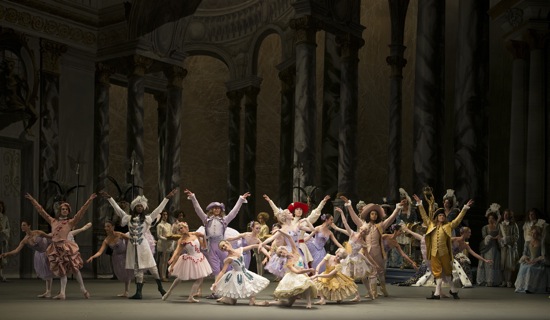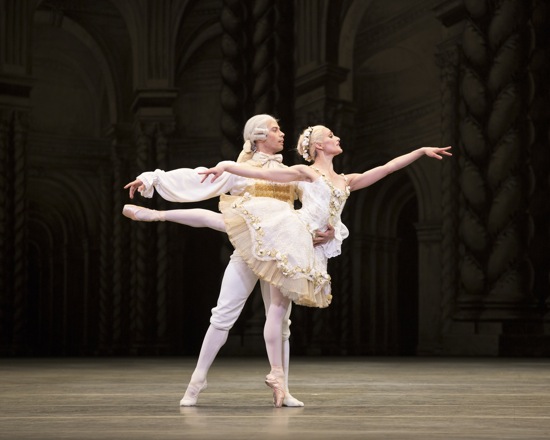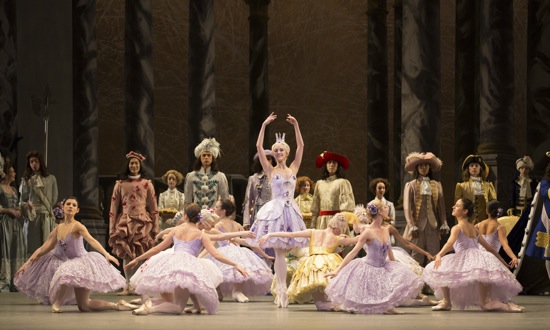Alexei Ratmansky brings an 1890 ballet to new life for American Ballet theatre.

The Prologue in Alexei Ratmansky’s The Sleeping Beauty: the gift-bearing fairies and their six cavaliers. Photo: Gene Schiavone
American Ballet Theatre is no stranger to The Sleeping Beauty. As Ballet Theatre, the new company in town in 1941, the dancers performed Princess Aurora, Anton Dolin’s mash-up of elements from the Prologue and Act III of Marius Petipa’s 1890 masterwork. ABT presented its first full-length version in 1976, its second in 1987, and its third in 2007—each staged “after Petipa” by a different regisseur or choreographer, and all staggering slightly under the weight of virtuosic interpolations and other revisions. Kevin McKenzie, ABT’s artistic director, was responsible for the 2007 version. With generosity and imagination, he has allowed that and the previous versions to give way to a new Sleeping Beauty staged by Alexei Ratmansky, and his discernment is rewarded every time this beautiful ballet is performed.
What Ratmansky put on the stage is indeed new—new in the sense of fresh, revitalized, and full of details in the choreography and the staging that we haven’t seen before. But in order to do this, he searched backward toward 1890 via the Stepanov notation of the ballet, which was brought to western Europe by Nicholas Sergeyev when he fled Russia in 1919. Sergeyev had been a fourteen-year-old student in the Imperial Ballet School in 1890 and may well have swelled Sleeping Beauty’s enormous cast.
Ratmansky and his wife, Tatiana Ratmansky, taught themselves to read the notation and to make sense of what they found and what they didn’t find (the arm movements were not always notated, for instance) and set to work with the ABT dancers. To their great credit, these performers didn’t behave like members of Russia’s Kirov Ballet when a historically accurate staging was attempted in 1999. Ballerinas reportedly tore off and stamped on the recreated 1890s costumes. They wanted their legs seen. They also wanted every arabesque to point at the moon and would not be dissuaded.
The choreographer did not return to 1890 for all his production ideas. Designer Richard Hudson was inspired by Léon Bakst’s scenery and costumes for The Sleeping Princess, the 1921 reconstruction by Serge Diaghilev’s Ballets Russes, and most of them are grand and gorgeous. Only one aspect of the costumes bothers me. Diaghilev almost lost his shirt on Sleeping Beauty, and ABT may have had to do a little cost-cutting. Therefore some of the costumes are made of lighter material. This means that when a female dancer, wearing a full skirt that comes almost to her knees, has to spin rapidly (as Aurora does in the Vision Scene), everything up to her navel is revealed—a sight that conflicts with the relative modesty of the attire in a period when giant hats all but covered gentlemen’s faces. In Act I, when Princess Aurora has pricked her finger and fallen into her hundred-years sleep, and other courtiers are sliding to the floor, curious small pear-shaped projections drift down. What can these be? Gigantic lilac petals in honor of the Lilac Fairy and the six young neophyte fairies that she has stationed to guard the enchanted castle?
Portions of the choreography have changed. For instance, Prince Désiré’s solo in the last act pas de deux is a veritable feast of batterie. The various intricate beaten jumps—entrechats, cabrioles, plus gargouillades et al— supersede the usual larger leaps with pauses to prepare. The result is an unbroken stitchery of nimble steps that seem, as the splendid Herman Cornejo performed them in the cast I saw, to be less about showing off for the audience than making a complicated and joyful wedding vow. In the pas de deux’s coda, a handsome repeated phraselet, with an assisted spin by Aurora into a side extension of one leg, has been substituted for the sequence in which she usually takes one spectacular fish dive after another into her savior’s arms; instead, a single such maneuver comes later.
Ratmansky’s research and direction has resulted in a gentler, more lyrical Sleeping Beauty. When the dancers step into what are usually arabesques, they bend the knee of their lifted leg slightly, softening and rounding the image. You don’t feel them working to maintain a 180-degree turnout. They endeavor not to lift their legs above 90 degrees. Also notable is the pliancy of their torsos; they bend, arch, and often use their use their upper bodies fluently as they step, say, into a slight turn. Too, some passages that have been puzzling in the past suddenly blossom into meaning. When Aurora in her Act I solo passes along a line of kneeling pages, tilting into an arabesque as she reaches each one and raising one hand to her cheek, you think, “so coy!” But in this Sleeping Beauty, the pages are holding violins, so her gesture becomes one of listening to each musician (or to what she imagines they will play), and a sweet detail is added to this sixteenth-birthday party. “Just listen to that!” she seems to be telling us and the assembled onstage guests, before darting off into some more celebratory dancing.

Sarah Lane and Herman Cornejo in the wedding pas de deux of The Sleeping Beauty, Act III. Photo: Rosalie O’Connor
Many other steps that you think you know well (like the Fairy Variations in the Prologue) look slightly different, but they haven’t been changed—just re-charged by timing and musical emphasis to glow anew. It’s been a long time since I’ve thought how Petipa must have decided to give the fairies lightness by creating an unusual amount of sustained pointework for their solos.
The costumes have an effect on the choreography. There isn’t a pancake tutu in sight. And, although the royal pair’s all-white costumes for the last act are surprisingly plain considering the occasion, Aurora has a skirt she can take hold of and swish daintily as she enjoys her flashing feet.
I have always admired Ratmansky’s ability to make characters seem vulnerable and responsive to changes in the emotional weather. The gorgeously clad queen (Karen Uphoff in the cast I saw) doesn’t just wring her hands and look distraught when Aurora (Sarah Lane) pricks her finger on a (forbidden) spindle and falls asleep; she tries to awaken her daughter and collapses over her recumbent form—forget her silk gown and monumental wig, this is her child! The entire population of this fairy-tale kingdom seems alert to what’s going on in its midst.
This choreographer is also not afraid of the classical mime and less codified gestures that once took up many bars of music, and he has directed them wonderfully. When the prince’s chaste kiss awakens the princess, and the guests who have shared her hundred-year sleep pick themselves up and dust themselves off, the king’s gesture of “Take her, dear boy; she’s yours!” has a spontaneous exuberance born of relief and gratitude (Roman Zhurban played the role in the cast I saw). Aurora herself, amid the last-act celebrations, gestures to her savior what looks like, “Yes, I will marry you.” I believe she’s actually saying, “Isn’t it fine that we’re getting married?” That she “says” anything at all gives me a little jolt of pleasure.
Surprises pop up in unusual places. Among the last-act fairy-tale vignettes, we have a Cinderella clumping along on one shoe, who pokes the eager prince with the tip of her bellows as if he were a cat come to steal the cream. And speaking of cats, Sean Stewart plays a very sensual Puss-in- Boots, agitating his hips silkily as he stalks the White Cat (Isadora Loyola). The six adroit little boys who follow their brother, Hop-o-my-Thumb (Seth Koffler), watch excitedly while he sneaks up to the sleeping, huge-headed Ogre (Thomas Harrison) and bravely pulls one of his boots off. The game of Blind Man’s Buff in Act II, when assorted members of the aristocracy are picnicking, acquires a bit of an edge; the ladies tease the blindfolded Galifron, the prince’s tutor (Clinton Luckett); he grabs and embraces one of them, whereupon she gives him a smack for being fresh above his station. No wonder Prince Désiré stares moodily into the distance (as heroes of Romantic ballets are wont to do).
A few points in the narrative and staging are a bit blurry. Carabosse is invited to the wedding (a good idea, considering what ensued when she didn’t get an invitation to the christening). But she more or less disappears into the crowd of revelers. The point at which Aurora actually gets the fateful spindle isn’t fully visible. (A minor point re spindles. They can be sharp, and knitting needles are not, yet the surreptitious knitters of Act I have to beg for their lives when discovered.)
There are five changes of cast for Aurora and her prince in this beautiful, invigorated Sleeping Beauty, which plays again at the Met from June 8 through 13. Lane is a small, vivid woman, and she made the occasion of the Aurora’s debut party into a sparkling one. Her feet appeared swifter than those of anyone else onstage; she tossed off the finicky little precipités (a springy foot action that has the thrust of a rapidly digging animal’s paw) with ebullient precision and the larger ones with elation.
At this particular performance, she began to tilt slightly off-balance in the endurance test known as the “Rose Adagio,” and briefly put her lifted leg down. She recovered instantly, of course, with the help of the last of her four partners. I usually find myself on the brink of tears during this pretty sequence. To me, it’s not just as a virtuosic display of hardihood on pointe, but a young girl’s ordeal in front of her parents’ court. Lane may have been dismayed, but on this occasion, I took her tiny slip-up as just more evidence of Aurora’s vulnerability in this brave event.
Cornejo, one of the company’s greatest male dancers, wears Désiré’s nobility marvelously. Never stiff and pompous, he looks born to be king some day—once he gets over his yearning for something more meaningful than casually hitting an arrow into a target that’s sitting in the Act II garden for his pleasure. He doesn’t do a great deal of dancing (the eloquent performer, Pavel Gerdt, was 46 when Petipa created the role on him), but in everything he does—in addition to the solo mentioned above—he is exemplary.

The Prologue of Alexei Ratmansky’s production of The Sleeping Beauty for American Ballet theatre. Devon Teuscher as the Lilac Fairy, surrounded by her attendants and backed by the principal fairies’ cavaliers. Photo: Rosalie O’Connor
Carabosse, the wicked fairy who avenged a forgotten invitation, was played by a man (Enrico Ceccheti) in 1890, and two ABT men play her this season: Craig Salstein and Marcelo Gomes (taking a break from his appearances as Désiré). I saw instead Nancy Raffa, once an ABT dancer, now a company ballet mistress. Her Carabosse is tiny, mean, and mercurial, with evil power to burn. The little-boy rats who follow her around have a hard time getting her black train out of her way. And it’s a nice touch to have the rats ape the courtiers’ grand manners for their own amusement.
Alexei Agoudine does a fine job as the hapless Chief Minister Catalbutte, whose omission of Carabosse from the Christening of Aurora precipitated the trouble. And Devon Teuscher performs the Lilac Fairy’s solo with the graciousness it demands and acts the role of the Prince’s guide and Carabosse’s opponent with aplomb. (Yes, Aurora will prick her finger, but, no, she will not die; she’ll sleep for a hundred years and be awakened by a prince’s kiss. How’s that for arbitration?)
A similar ease and musicality characterizes Skylar Brandt, Nicole Graniero, Luciana Paris, and Gemma Bond in the Wedding Celebration’s “Precious Stones” dances. Stella Abrera and Blaine Hoven dance the “Bluebird” pas de deux excellently—she with a lovely suspension of breath in her opening steps, he with the requisite soarings , his feet beating together in the air like wings. She becomes more birdlike and less “Princess Florine” as they reach the coda.
David LaMarche was the excellent conductor at the May 30th matinee (with an audience peppered with children). It was wonderful to hear Tchaikovsky’s score take on new life, as if in response to Ratmansky’s renewed Sleeping Beauty. The revival is a tremendous accomplishment for everyone connected with it. The ballet doesn’t look like an antique; it’s a beauty that a choreographer’s kiss has awakened.

Thank you for a great review. As a dancer and aspiring choreographer I always enjoy reading your work.
Dear Deborah,
Thank you for your toil. You have given a delectable description of this new Ratmansky production. You have given me an insight to why I truly appreciate his work – with its great flexibility moment to moment. I only wish I could see the ballet, but reading this was the next best thing.
Toil on!!!
Deborah
Your joyous and detailed review inspired me to make a pointe of seeing this new interpretation of Sleeping Beauty